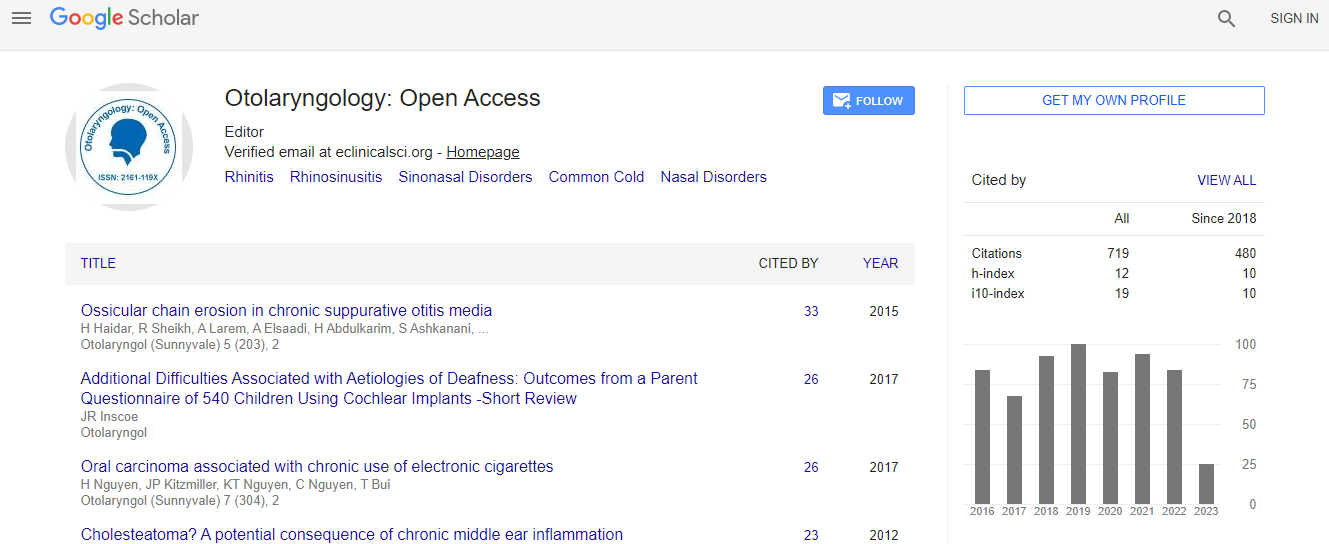Our Group organises 3000+ Global Conferenceseries Events every year across USA, Europe & Asia with support from 1000 more scientific Societies and Publishes 700+ Open Access Journals which contains over 50000 eminent personalities, reputed scientists as editorial board members.
Open Access Journals gaining more Readers and Citations
700 Journals and 15,000,000 Readers Each Journal is getting 25,000+ Readers
Google Scholar citation report
Citations : 925
Otolaryngology: Open Access received 925 citations as per Google Scholar report
Otolaryngology: Open Access peer review process verified at publons
Indexed In
- Index Copernicus
- Google Scholar
- Sherpa Romeo
- Open J Gate
- Genamics JournalSeek
- RefSeek
- Hamdard University
- EBSCO A-Z
- OCLC- WorldCat
- Publons
- Geneva Foundation for Medical Education and Research
- ICMJE
Useful Links
Recommended Journals
Related Subjects
Share This Page
Hadad Flap and Skull base Reconstruction
Joint Event on 4th European Otolaryngology-ENT Surgery Conference & 3rd International Conference on Craniofacial Surgery
Rijuneeta Gupta, Dandapani SS
Professor, Dept of Otorhinolaryngology HNSPGIMER, Chandigarh, India
ScientificTracks Abstracts: Otolaryngol (Sunnyvale)
Abstract
Endonasal endoscopic Approach (EEA) has revolutionized the surgical management of sinonasal and skull base pathologies. The utility of the EEA was initially limited to very small defects using multilayered free nonvascularized tissue grafts including mucoperichondrium, mucoperiosteum, fascia, fat grafts or alloderm and synthetic grafts. However EEA led to 20-30 % incidence of cerebrospinal fluid (CSF) leaks in large intradural lesions (>2 cm ) beyond the confines of the sella.The HADAD-BASSAGASTEGUY FLAP (HB flap), a pedicled, vascularized, mucosal flap of the nasal septum with mucoperichondrium and mucoperiosteum based on the nasoseptal artery was described recently. The HB flap a “Work-horse" flap for anterior skull base reconstruction is sturdy, pliable , versatile, highly vascularized with pedicled blood supply, provides an enough surface area for complete healing with decreased risk of CSF leak. Indications of HB flaps are skull base reconstruction after endonasal surgery for congenital cysts, large multilobulated pituitary tumours, meningiomas, craniopharyngiomas, clival chordomas and larger CSF leaks (traumatic or spontaneous)
The ultimate goals are to have the stable separation between the nose and the cranial cavity, the protection of neurovascular structures, the conservation or reconstruction of cosmesis and the avoidance of dead spaces. HB flap is not a viable option for reconstruction of very large anterior fossa defects, septal tissue or sphenoid rostrum involved by malignancy and children <10 years old. Postoperative complications can be CSF leak, encephalocele formation, mucocele formation, septal perforation and meningitis. Various studies have reported post-operative CSF leak rate from 4.5% to 24% after EEA. A number of modifications of Hadad flap have been reported in literature with significant advantages.
In our retrospective review of 78 patients postoperative CSF leak was seen in 2.7–4.4% with 97 % success rate.
Conclusion- HB flap is useful, reliable, meticulous multilayered technique with a sharp decrease in the incidence of post-operative CSF leak. The current literature has focused on feasibility and immediate perioperative outcomes. However, we need larger studies with longer follow up to know the long term outcome of HB flap.
Biography
Dr. Rijuneeta Gupta currently she is a Professor in the Department of Otolaryngology and HNS, Post Graduate Institute of Medical Education and Research, Chandigarh, India.
E-mail: rijuneeta@yahoo.com

 Spanish
Spanish  Chinese
Chinese  Russian
Russian  German
German  French
French  Japanese
Japanese  Portuguese
Portuguese  Hindi
Hindi 
